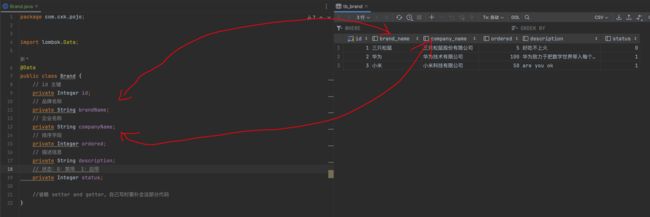MyBatis
Mybatis
官网:https://mybatis.org/mybatis-3/zh/getting-started.html
创建mybatis项目
- 导入坐标:
<dependencies>
<dependency>
<groupId>org.mybatisgroupId>
<artifactId>mybatisartifactId>
<version>3.5.5version>
dependency>
<dependency>
<groupId>mysqlgroupId>
<artifactId>mysql-connector-javaartifactId>
<version>5.1.46version>
dependency>
<dependency>
<groupId>junitgroupId>
<artifactId>junitartifactId>
<version>4.13version>
<scope>testscope>
dependency>
dependencies>
- 编写mybatis核心配置文件,具体可以在官网找到:
DOCTYPE configuration
PUBLIC "-//mybatis.org//DTD Config 3.0//EN"
"http://mybatis.org/dtd/mybatis-3-config.dtd">
<configuration>
<typeAliases>
<package name="com.itheima.pojo"/>
typeAliases>
<environments default="development">
<environment id="development">
<transactionManager type="JDBC"/>
<dataSource type="POOLED">
<property name="driver" value="com.mysql.jdbc.Driver"/>
<property name="url" value="jdbc:mysql:///mybatis?useSSL=false"/>
<property name="username" value="root"/>
<property name="password" value="1234"/>
dataSource>
environment>
<environment id="test">
<transactionManager type="JDBC"/>
<dataSource type="POOLED">
<property name="driver" value="com.mysql.jdbc.Driver"/>
<property name="url" value="jdbc:mysql:///mybatis?useSSL=false"/>
<property name="username" value="root"/>
<property name="password" value="1234"/>
dataSource>
environment>
environments>
<mappers>
<mapper resource="UserMapper.xml"/>
mappers>
configuration>
- 创建Mapper映射文件UserMapper.xml
DOCTYPE mapper PUBLIC "-//mybatis.org//DTD Mapper 3.0//EN" "http://mybatis.org/dtd/mybatis-3-mapper.dtd">
<mapper namespace="test">
<select id="selectAll" resultType="com.itheima.pojo.User">
select * from tb_user;
select>
mapper>
- 创建实体类User
public class User {
private int id;
private String username;
private String password;
private String gender;
private String addr;
}
- 测试:
public class MyBatisDemo {
public static void main(String[] args) throws IOException {
//1. 加载mybatis的核心配置文件,获取 SqlSessionFactory
String resource = "mybatis-config.xml";
InputStream inputStream = Resources.getResourceAsStream(resource);
SqlSessionFactory sqlSessionFactory = new SqlSessionFactoryBuilder().build(inputStream);
//2. 获取SqlSession对象,用它来执行sql
SqlSession sqlSession = sqlSessionFactory.openSession();
//3. 执行sql
List<User> users = sqlSession.selectList("test.selectAll"); //参数是一个字符串,该字符串必须是映射配置文件的namespace.id
System.out.println(users);
//4. 释放资源
sqlSession.close();
}
}
Mapper代理开发
下面这个test.selectAll存在硬编码问题,可以使用Mapper代理的方式修改
Mapper代理开发步骤:
- 创建UserMapper接口:
public interface UserMapper {
List<User> selectAll();
}
- 修改命名空间,必须是接口对应的全限定名字:
- 修改测试类
//3.1 获取UserMapper接口的代理对象
UserMapper userMapper = sqlSession.getMapper(UserMapper.class);
List<User> users = userMapper.selectAll();
如果Mapper接口名称和SQL映射文件名称相同,并在同一目录下,则可以使用包扫描的方式简化SQL映射文件的加载。也就是将核心配置文件的加载映射配置文件的配置修改为
<mappers> <package name="com.itheima.mapper"/> mappers>
MyBatis核心配置文件
多环境配置
在核心配置文件的 environments 标签中其实是可以配置多个 environment ,使用 id 给每段环境起名,在 environments 中使用 default='环境id' 来指定使用哪儿段配置。
<environments default="development">
<environment id="development">
<transactionManager type="JDBC"/>
<dataSource type="POOLED">
<property name="driver" value="com.mysql.jdbc.Driver"/>
<property name="url" value="jdbc:mysql:///mybatis?useSSL=false"/>
<property name="username" value="root"/>
<property name="password" value="1234"/>
dataSource>
environment>
<environment id="test">
<transactionManager type="JDBC"/>
<dataSource type="POOLED">
<property name="driver" value="com.mysql.jdbc.Driver"/>
<property name="url" value="jdbc:mysql:///mybatis?useSSL=false"/>
<property name="username" value="root"/>
<property name="password" value="1234"/>
dataSource>
environment>
environments>=
类型别名
在映射配置文件中的 resultType 属性需要配置数据封装的类型(类的全限定名)。而每次这样写是特别麻烦的,Mybatis 提供了 类型别名(typeAliases) 可以简化这部分的书写。
<typeAliases>
<package name="com.itheima.pojo"/>
typeAliases>
如果写上面的了,那么resultType就可以简化了
<mapper namespace="com.itheima.mapper.UserMapper">
<select id="selectAll" resultType="user">
select * from tb_user;
select>
mapper>
数据库映射问题
如果Java的实体类和数据库里的字段不一致,可以使用起别名的方式来解决这个问题
<select id="selectAll" resultType="brand">
select
id, brand_name as brandName, company_name as companyName, ordered, description, status
from tb_brand;
select>
但是这种方式还是太麻烦,复用性不高,可以使用下面两种方式进行:
SQL片段引用:
<sql id="brand_column">
id, brand_name as brandName, company_name as companyName, ordered, description, status
sql>
<select id="selectAll" resultType="brand">
select
<include refid="brand_column" />
from tb_brand;
select>
使用resultMap
<resultMap id="brandResultMap" type="brand">
<result column="brand_name" property="brandName"/>
<result column="company_name" property="companyName"/>
resultMap>
<select id="selectAll" resultMap="brandResultMap">
select *
from tb_brand;
select>
注意接口的返回结果变成了resultMap而不是resultType
参数占位符
例如selectById接口,需要传入一个id,可以使用#占位符
<select id="selectById" resultMap="brandResultMap">
select *
from tb_brand where id = #{id};
select>
调用:
BrandMapper brandMapper = sqlSession.getMapper(BrandMapper.class);
Brand brand = brandMapper.selectById(id);
System.out.println(brand);
#存在SQL注入问题,可以使用$替换
<select id="selectById" resultMap="brandResultMap">
select *
from tb_brand where id = ${id};
select>
使用ParameterType可以指定参数的类型:
<select id="selectById" parameterType="int" resultMap="brandResultMap">
select *
from tb_brand where id = ${id};
select>
特殊符号
因为映射配置文件是xml类型的问题,而 > < 等这些字符在xml中有特殊含义,所以此时我们需要将这些符号进行转义,
例如:<可以使用<
多条件查询
编写接口:
- 使用
@Param("参数名称")标记每一个参数,在映射配置文件中就需要使用#{参数名称}进行占位
List<Brand> selectByCondition(@Param("status") int status, @Param("companyName") String companyName,@Param("brandName") String brandName);
测试:
@Test public void testSelectByCondition() throws IOException { //接收参数 int status = 1; String companyName = "华为"; String brandName = "华为"; // 处理参数 companyName = "%" + companyName + "%"; brandName = "%" + brandName + "%"; //1. 获取SqlSessionFactory String resource = "mybatis-config.xml"; InputStream inputStream = Resources.getResourceAsStream(resource); SqlSessionFactory sqlSessionFactory = new SqlSessionFactoryBuilder().build(inputStream); //2. 获取SqlSession对象 SqlSession sqlSession = sqlSessionFactory.openSession(); //3. 获取Mapper接口的代理对象 BrandMapper brandMapper = sqlSession.getMapper(BrandMapper.class); //4. 执行方法 //方式一 :接口方法参数使用 @Param 方式调用的方法 List<Brand> brands = brandMapper.selectByCondition(status, companyName, brandName); //5. 释放资源 sqlSession.close(); }
- 将多个参数封装成一个 实体对象 ,将该实体对象作为接口的方法参数。该方式要求在映射配置文件的SQL中使用
#{内容}时,里面的内容必须和实体类属性名保持一致。
List<Brand> selectByCondition(Brand brand);
测试:
//方式二 :接口方法参数是 实体类对象 方式调用的方法 //封装对象 Brand brand = new Brand(); brand.setStatus(status); brand.setCompanyName(companyName); brand.setBrandName(brandName); List<Brand> brands = brandMapper.selectByCondition(brand);
- 使用Map映射,将map集合作为接口的方法参数。该方式要求在映射配置文件的SQL中使用
#{内容}时,里面的内容必须和map集合中键的名称一致。
List<Brand> selectByCondition(Map map);
测试:
//方式三 :接口方法参数是 map集合对象 方式调用的方法 Map map = new HashMap(); map.put("status" , status); map.put("companyName", companyName); map.put("brandName" , brandName); List<Brand> brands = brandMapper.selectByCondition(map); System.out.println(brands);
SQL语句如下:
<select id="selectByCondition" resultMap="brandResultMap">
select *
from tb_brand
where status = #{status}
and company_name like #{companyName}
and brand_name like #{brandName}
select>
动态SQL
每个字段不一定全部都输入,需要判断是否存在,可以使用if条件判断
<select id="selectByCondition" resultMap="brandResultMap">
select *
from tb_brand
where
<if test="status != null">
and status = #{status}
if>
<if test="companyName != null and companyName != '' ">
and company_name like #{companyName}
if>
<if test="brandName != null and brandName != '' ">
and brand_name like #{brandName}
if>
select>
这样也存在问题,如果没有输入status,SQL会变成:
select * from tb_brand where and company_name like ? and brand_name like ?
可以使用where语句解决:会动态的去掉第一个条件前的 and
<select id="selectByCondition" resultMap="brandResultMap">
select *
from tb_brand
<where>
<if test="status != null">
and status = #{status}
</if>
<if test="companyName != null and companyName != '' ">
and company_name like #{companyName}
</if>
<if test="brandName != null and brandName != '' ">
and brand_name like #{brandName}
</if>
</where>
</select>
注意:需要给每个条件前都加上 and 关键字。
单条件查询
在查询时只能选择 品牌名称、当前状态、企业名称 这三个条件中的一个,可以使用choose标签
<select id="selectByConditionSingle" resultMap="brandResultMap">
select *
from tb_brand
<where>
<choose><!--相当于switch-->
<when test="status != null"><!--相当于case-->
status = #{status}
</when>
<when test="companyName != null and companyName != '' "><!--相当于case-->
company_name like #{companyName}
</when>
<when test="brandName != null and brandName != ''"><!--相当于case-->
brand_name like #{brandName}
</when>
</choose>
</where>
</select>
增删改查
增加
<insert id="add">
insert into tb_brand (brand_name, company_name, ordered, description, status)
values (#{brandName}, #{companyName}, #{ordered}, #{description}, #{status});
</insert>
如何判断是否成功?可以添加主键返回,执行完之后可以打印id
<insert id="add" useGeneratedKeys="true" keyProperty="id">
insert into tb_brand (brand_name, company_name, ordered, description, status)
values (#{brandName}, #{companyName}, #{ordered}, #{description}, #{status});
</insert>
- useGeneratedKeys:是够获取自动增长的主键值。true表示获取
- keyProperty :指定将获取到的主键值封装到哪儿个属性里
删除
<delete id="deleteById">
delete from tb_brand where id = #{id};
</delete>
批量删除
接口传入的参数为数组
/**
* 批量删除
*/
void deleteByIds(int[] ids);
SQL 语句:
编写SQL时需要遍历数组来拼接SQL语句。Mybatis 提供了 foreach 标签用来迭代任何可迭代的对象(如数组,集合)。
- collection 属性:
- mybatis会将数组参数,封装为一个Map集合。
- 默认:array = 数组
- 使用@Param注解改变map集合的默认key的名称
- mybatis会将数组参数,封装为一个Map集合。
- item 属性:本次迭代获取到的元素。
- separator 属性:集合项迭代之间的分隔符。
foreach标签不会错误地添加多余的分隔符。也就是最后一次迭代不会加分隔符。 - open 属性:该属性值是在拼接SQL语句之前拼接的语句,只会拼接一次
- close 属性:该属性值是在拼接SQL语句拼接后拼接的语句,只会拼接一次
<delete id="deleteByIds">
delete from tb_brand where id
in
<foreach collection="array" item="id" separator="," open="(" close=")">
#{id}
</foreach>
;
</delete>
假如数组中的id数据是{1,2,3},那么拼接后的sql语句就是:
delete from tb_brand where id in (1,2,3);
修改
<update id="update">
update tb_brand
<set>
<if test="brandName != null and brandName != ''">
brand_name = #{brandName},
</if>
<if test="companyName != null and companyName != ''">
company_name = #{companyName},
</if>
<if test="ordered != null">
ordered = #{ordered},
</if>
<if test="description != null and description != ''">
description = #{description},
</if>
<if test="status != null">
status = #{status}
</if>
</set>
where id = #{id};
</update>
set 标签可以用于动态包含需要更新的列,忽略其它不更新的列。
注解开发
直接在接口语句上面写SQL即可:
- 查询 :@Select
- 添加 :@Insert
- 修改 :@Update
- 删除 :@Delete
@Select(value = "select * from tb_user where id = #{id}")
public User select(int id);
虽然简单,但是无法完成复杂的SQL语句。



